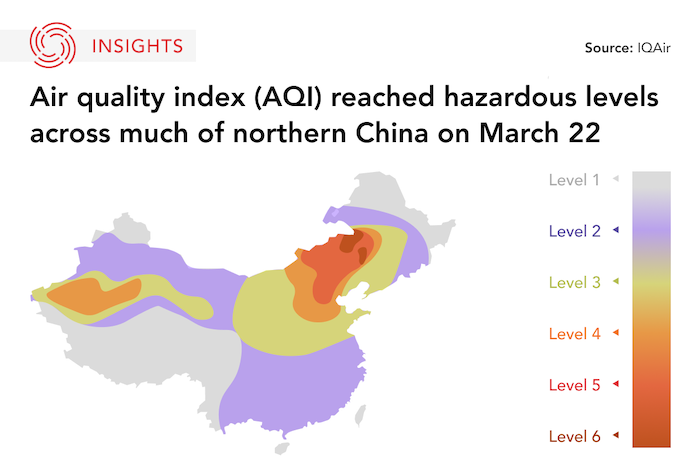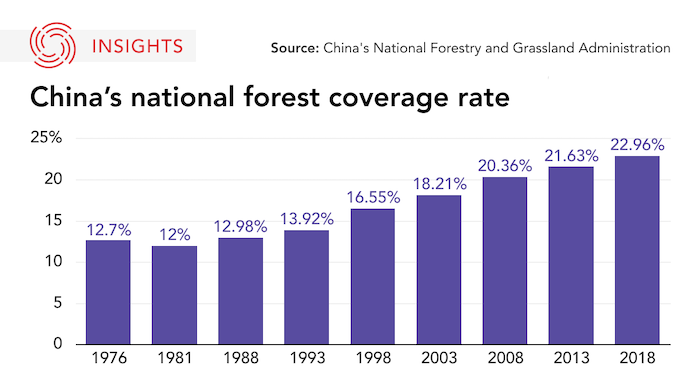The Takeaway
A major sandstorm swept northern China in late March, reviving memories for many in the region of the heavy pollution from decades ago. The extreme weather event, which temporarily disrupted life for hundreds of millions, is a reminder that desertification in the country’s west threatens the health of nearly all its residents. Reforestation campaigns have bought time for the country, but substantive climate resilience measures are needed for long-term security.
In Brief
China’s National Meteorological Center (NMC) issued sandstorm warnings for four days in a row (from March 19 to March 22) for much of northern China, responding to the region’s most severe sandstorm of 2023. The concentration of PM10 particles reached 1,667 micrograms per cubic metre in Beijing on March 22, roughly 37 times higher than the daily guideline levels set by the World Health Organization. Zhang Tao, NMC’s chief meteorologist, told Shanghai-based The Paper that the sandstorm was likely caused by strong, cool winds from Mongolia passing through Inner Mongolia and Gansu. Dust from these desertified regions then travelled east and south, leading to “rains of mud” in eastern cities.
The sandstorm occurred at an especially inopportune time for local cadres, arriving on the heels of the annual “Two Sessions.” Around major political events (when officials' performances are reviewed), local governments often strive to ensure literal blue skies, sometimes through radical measures like halting industrial production and banning coal fires. The wide sweep of the sandstorm, affecting residents from northwestern Xinjiang all the way to coastal Jiangsu, made it a popular topic on social media. As ’netizens’ shared images of dirtied clothes and dark-yellow skies, there is renewed public attention toward the root causes of pollution and the country’s campaign for fresh air.

Implications
China’s air quality has steadily improved since the 2010s, as national and local authorities pursued aggressive campaigns to reduce pollution. The country’s most iconic anti-pollution policy is, perhaps, a tree-planting drive: beginning in 1978 with the Three-North Shelter Forest Program, China plans to construct a “Green Great Wall” to hold off desertification by 2050. Since 2012, around 640,000 square kilometres of new forests — equal to roughly the size of Manitoba — have been planted across China. Though experts disagree on the impact of this policy with regards to biodiversity and water conservation, most believe that the reforestation drives have significantly contributed to reducing carbon emissions and air pollution.

However, trees may no longer be enough to hold off powerful sandstorms. Zhang Tao told The Beijing News that this storm's severity was, in part, due to an unusually warm early March in northern China, which rapidly melted permafrost and seasonally frozen ground. A strong wind then swept up loosened dirt and sand, making the storm particularly damaging. As the planet warms, Mongolia and northern China are seeing less precipitation and intensifying desertification, while cyclone patterns become less predictable. All these factors will lead to more volatile and powerful sandstorm seasons, which will seriously disrupt livelihoods and threaten public health across the populous region.
What's Next
- Southern China braces for new climate reality
Around 60 to 70 per cent of sandstorms occur between March and May in China, and experts are awaiting data for the next two months to draw conclusions on the overall severity of this year’s storm. The March sandstorm affected coastal and central regions usually spared from sandstorms, and there were fears that it could even reach Shanghai. Southern China, mostly warm and humid, is unfamiliar with inland wind damage and lacks the relevant infrastructure to prevent it. If sandstorms become a bigger risk, the region will need to rapidly invest to adapt to a new climate reality.
- Local government budget shortfalls threaten green projects
For decades, environmental improvement projects like tree-planting have received generous funding from the coffers of local governments, as cadres strive to “beautify” their regions in hopes of being promoted. As the country emerges from the COVID-19-induced economic downturn, local governments are cutting public spending to keep themselves afloat. Environmental projects like tree-planting may be on the chopping block, creating yet another roadblock on the way to cleaner air.
- Reaching across the region for climate collaboration
A significant portion of sandstorms in northern China, including the storm in March, originate in Mongolia. China offered the landlocked country assistance in addressing environmental issues in 2021 after a major sandstorm killed 10 people and thousands of livestock in both countries. Though multilateral relations in East Asia remain contentious, climate activists and researchers continue to call on China, Mongolia, the Korean Peninsula, and Japan to collaborate on environmental mitigation.
• Produced by CAST’s Greater China team: Maya Liu (Program Manager); Irene Zhang (Analyst); Liam Lau (Analyst); and Dustin Lo (Analyst).




